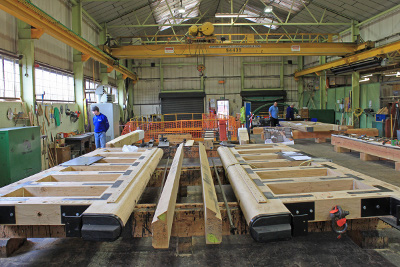THE lock gate workshops of Canal & River Trust are bringing in improvements in production.
The workshops at both Bradley in the West Midlands (pictured) and Stanley Ferry in Yorkshire, are bringing forward several small changes to lock gate production to increase speed and efficiency.
 Constant cycle of production
Constant cycle of production
With over 1,500 locks across the Trust’s canal network, and a working life of typically 25 years, there is a constant cycle of production and replacement of old lock gates. This year the trust’s specialist team is producing 123 separate lock gate leaves for installation across the network.
The small changes to production will save the team 25 working days each year, enough time to produce at least an additional two top end single lock gates or one set of bottom end mitre gates.
A working group including workshop carpenters, heritage specialists, engineers and volunteer boaters on the Trust’s Navigation Advisory Group has brought forward the changes.
Painting
One change agreed by the group is to only paint lock gate steelwork that is above the waterline. As the painting is purely decorative, this will retain the characteristic look while whilst having no impact on the resilience of the gate.
Standardised designs are now in place for the Shropshire Union Canal, Birmingham Canal Navigations and Worcester & Birmingham Canal, with work ongoing for the Oxford, Stratford and Montgomery canals.
Further location-specific changes, in some instances requiring consent from local authorities, will see an alteration to the design of the bottom end gates on the Grand Union Canal which will negate the need for a second horizontal layer of planking without compromising the performance of the gate.
Save money on materials
The group has looked at ways the trust can save money on materials. In conjunction with engineers from the Timber Research & Development Association it has refined the Lock Gate Calculation sheets. These calculate the size of timber required to achieve the required strength of the lock gate. The new sheet allows the teams to try different timber sizes and is likely to produce a saving of 5% on timber usage.
